The Samsung 850 EVO 4TB SSD Review
by Billy Tallis on July 11, 2016 10:00 AM ESTMixed Random Read/Write Performance
The mixed random I/O benchmark starts with a pure read test and gradually increases the proportion of writes, finishing with pure writes. The queue depth is 3 for the entire test and each subtest lasts for 3 minutes, for a total test duration of 18 minutes. As with the pure random write test, this test is restricted to a 16GB span of the drive, which is empty save for the 16GB test file.
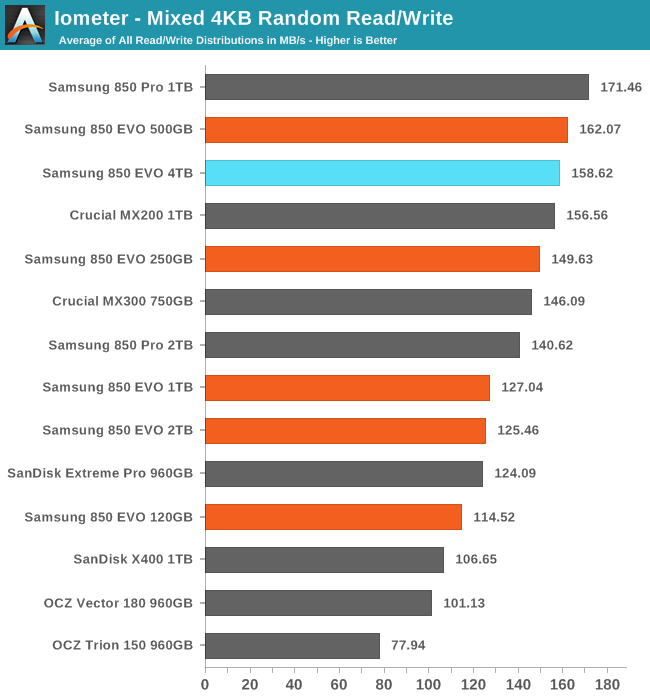
The mixed random I/O performance of the 4TB 850 EVO is much better than the other large 850 EVOs, putting te 4TB model close to the top of the chart.
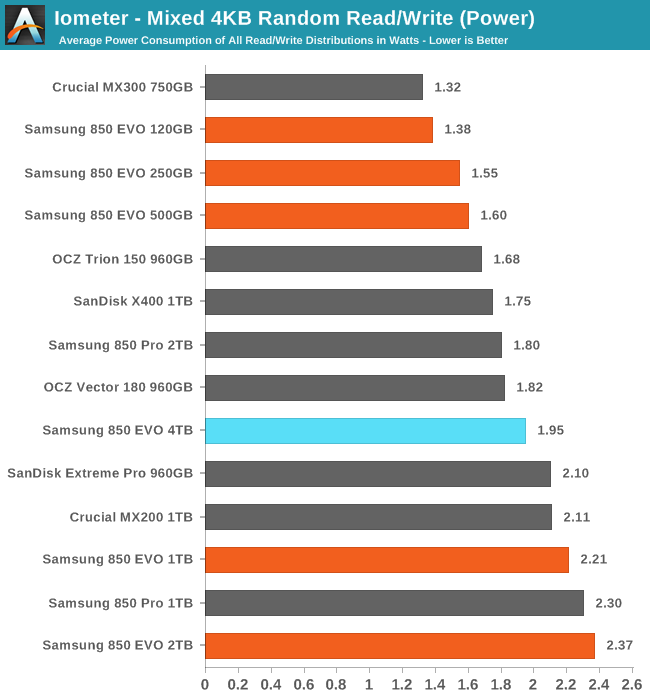
The 4TB 850 EVO also manages a large reduction in power usage as compared with the 1TB and 2TB 850 EVOs, making the 4TB much more efficient.
 |
|||||||||
Unlike the other 850 EVOs, the 4TB never loses performance as the proportion of writes in the test workload increases. Meanwhile, the power draw is essentially constant until near the end of the test.
Mixed Sequential Read/Write Performance
The mixed sequential access test covers the entire span of the drive and uses a queue depth of one. It starts with a pure read test and gradually increases the proportion of writes, finishing with pure writes. Each subtest lasts for 3 minutes, for a total test duration of 18 minutes. The drive is filled before the test starts.
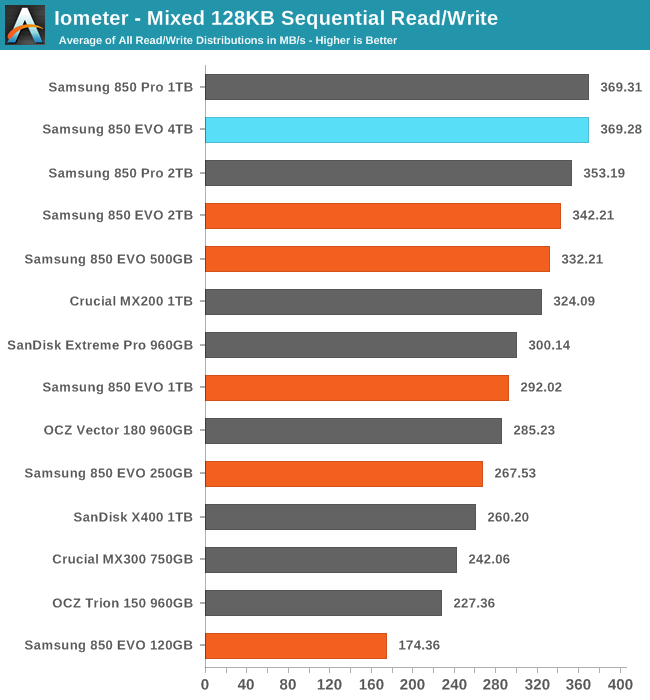
The 4TB 850 EVO is essentially tied for the best mixed sequential read and write performance.
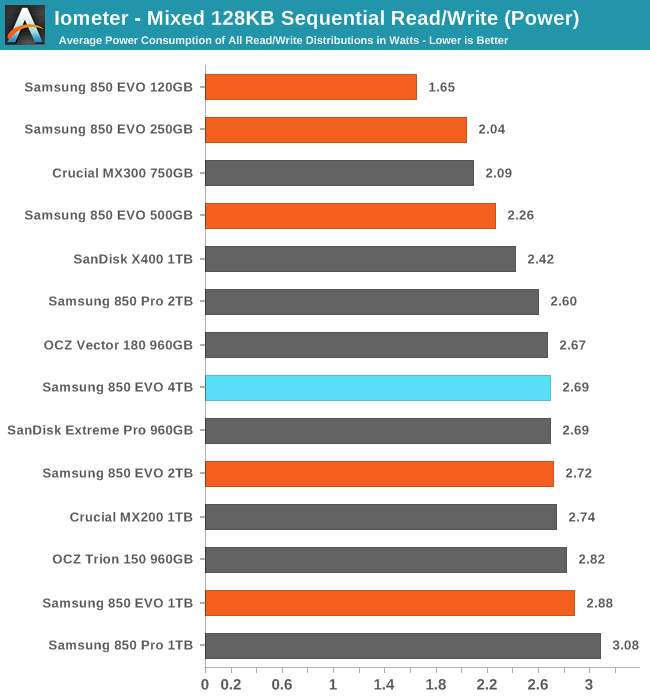
The 4TB 850 EVO averages using slightly less power than the 2TB model, and it is one of the most efficient of the large drives.
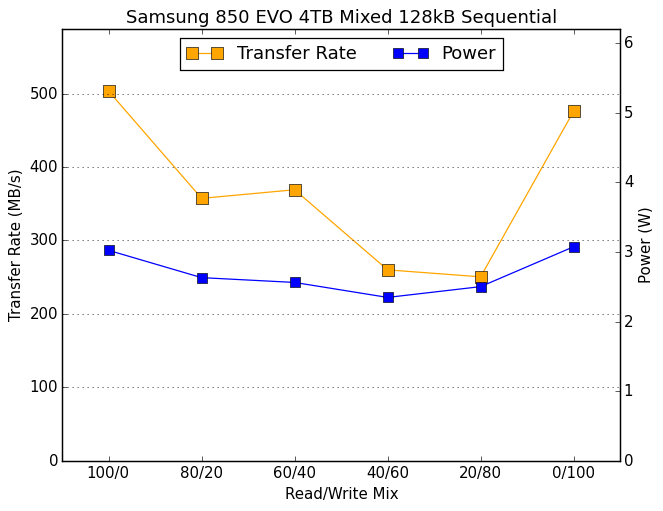 |
|||||||||
The usual pattern is for performance on this test to resemble a bathtub curve, but the 2TB 850s and the 4TB 850 EVO don't lose as much of their performance during the first half of the test, leading them to bottom out much later than most other drives.










145 Comments
View All Comments
Samus - Monday, July 11, 2016 - link
But you could buy 8TB of MLC-based Mushkin Reactor for the price of 4TB of 850 EVO. Then you consider a RAID of Reactors will be 4x the sequential performance of a 850 EVO.And let's face it, with a storage drive like a 4TB SSD, sequential performance is all that really matters unless you actually plan to use it as a boot/system drive.
ACE76 - Monday, July 11, 2016 - link
http://www.fudzilla.com/news/memory/39668-mushkin-...I can't wait for this...at $500 for 4tb, I'd move all my media over to SSDs in a RAID 10 array.
Ian Cutress - Tuesday, July 12, 2016 - link
We got clarification from Mushkin at the time when we posted similar: the $500 price point was actually a mischaracterization. The initial price would be much closer to $1000, with $500 being a goal nearer EOL.Oxford Guy - Monday, July 11, 2016 - link
How does TRIM fit into the picture of RAIDed ssds, though?Impulses - Tuesday, July 12, 2016 - link
TRIM has been working on RAID for a while, years actually, at least on Intel's newer chipsets... They kept it from older chipsets (like my old rig's P67) but enterprising users back ported it thru BIOS edits/hacks.Impulses - Tuesday, July 12, 2016 - link
Not that I'm against the EVOs, running 2x 1TB in RAID myself.bittermann - Monday, July 11, 2016 - link
Good luck fitting 4TB of data on that 1TB drive....Spoogie - Monday, July 11, 2016 - link
With Optane on the horizon, no reason to bite at this price point.Flunk - Monday, July 11, 2016 - link
I don't think it's the same market. Optane isn't going to be less than $1 a GB at the start.patrickjp93 - Monday, July 11, 2016 - link
65 cents/GB actually.